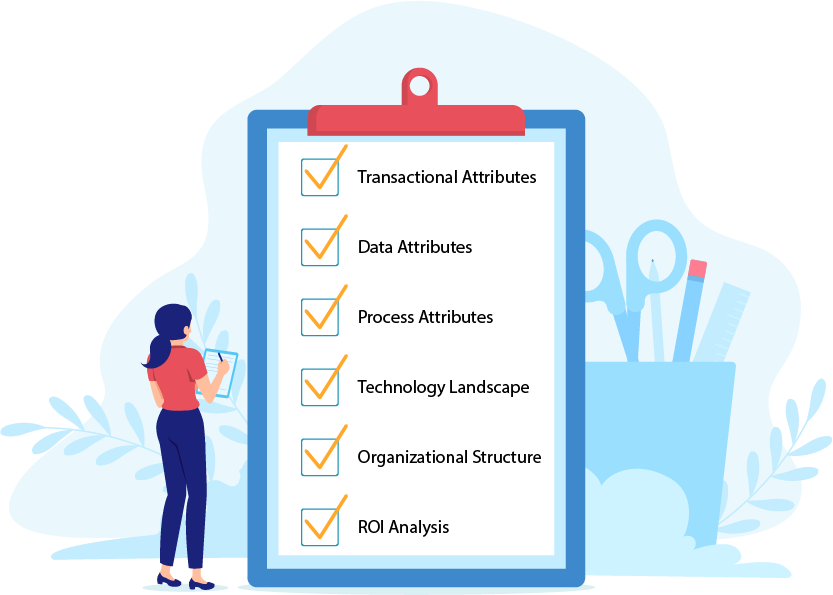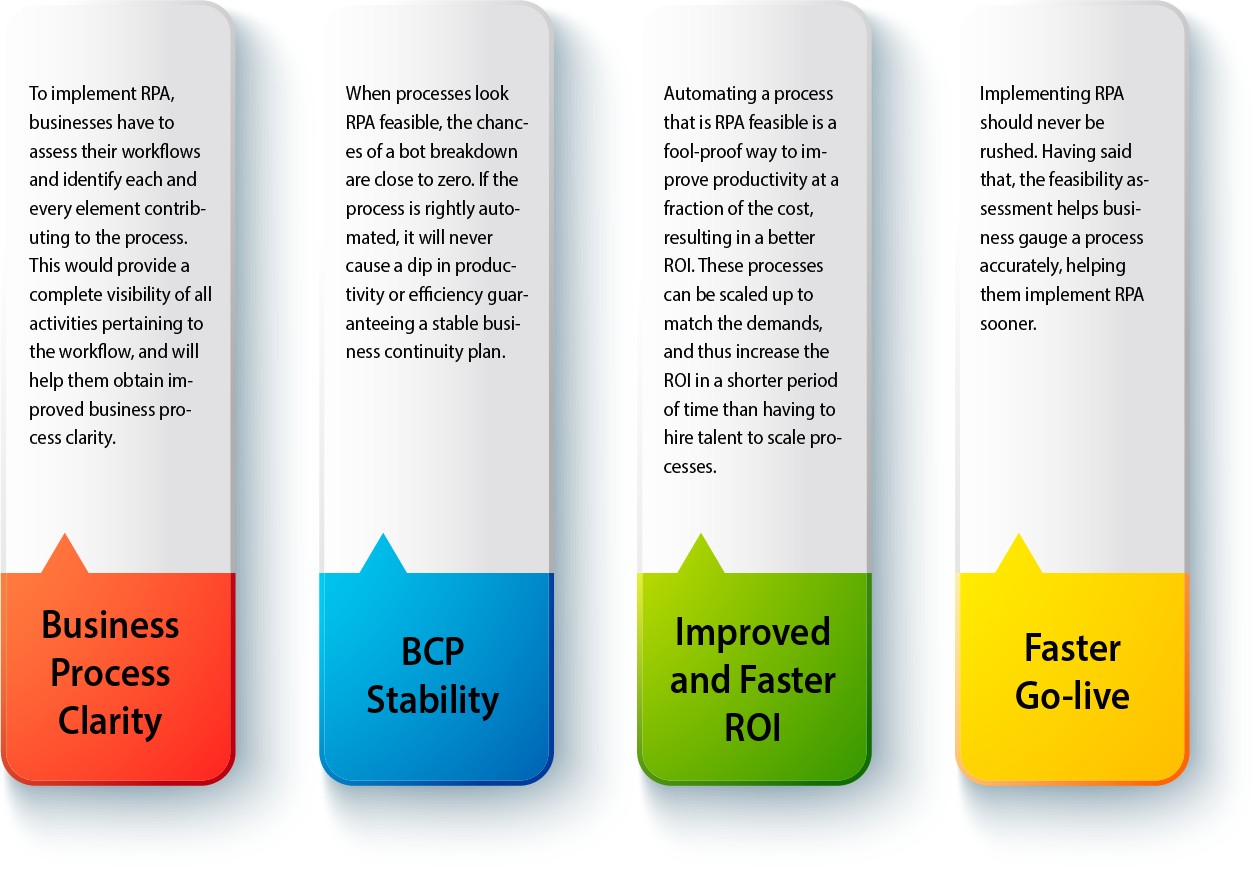RPA Implementation is one of the most crucial steps in digital transformation. It is known to enhance efficiency, productivity, and customer engagement, helping businesses move ahead of competition. Although implementing RPA is not everybody’s cup of tea, with the right checklist/guidance, teams can implement RPA with ease.
An RPA feasibility assessment is a practice to assess/gauge whether a process is feasible to automate a business workflow process using bots. Checking the feasibility of a process is one of the most vital steps in an RPA implementation framework.
Not all processes are automation friendly or worthy. RPA bot failures and breakdowns are usually the consequence of automating a process that was incorrectly deemed worthy. A study by EY claims that 30%-50% of RPA projects fail globally on account of various drawbacks. Thereby, the RPA feasibility assessment is necessary to weed out all that is unnecessary.
Parameters for RPA Feasibility

-
Transaction Volumes
The core principle of RPA is to automate activities that are carried out on user interfaces. To make profits with an RPA, the bigger the transaction volume the better. This means, the process must be frequently used with plenty of human involvement. Human involvement results in errors, which can be mitigated by the RPA.
In short, when business processes are high in transactional volume, it’s a green signal for RPA feasibility.
Also Read: Introduce RPA in education institutions and handle large transactional volumes with ease.
-
Data Attributes
Understanding the data types within the processes selected for feasibility assessment is a must. Data types can vary from Boolean, numeric, date-time, string, GenericValue, data tables, to arrays. Mapping the processes to their data types helps developers customize the RPA bot to function effectively.
-
Digitized Data
All data that is necessary for the process to execute must be in a digitized format in accessible locations within the organizational network. If any part of the process involves data entry from a source that is non-digital that process need not even be considered to undergo the feasibility assessment.
-
Structured Data
Unstructured data causes a lot of confusion while programming RPA bots, and it is best to avoid it. The bot will do as the bot is told, and when it does not find the data in the location referenced, the bot function will fail. Therefore, a process needs to have data in a structured form to fulfil the feasibility criteria.
The processes that require automation must be accurately mapped to identify the volume of data that will be handled by an RPA bot. Failing to note down the large data volume intersections in business workflows can result in a bot failure.
Must Read: Offload the pressure of high costs and automate your healthcare revenue cycles.
-
-
Process Attributes
Process attributes are very much like the characteristics that make the business process unique.
-
Complexity Analysis
The processes chosen for RPA implementation must be rule-based. RPA bots are just automation experts, and cannot carry out intelligent tasks or make decisions based on past experience.
RPA bots cannot automate processes that are increasingly complex, either. Complex processes need to be broken into factions with specific functions for successful RPA implementation.
-
Scalable
To automate a process, it is not enough that the transaction volumes are high, the process must also be scalable. It is only then that organizations can really reap the benefits of it, in in the long run. This way the RPA can cover more ground in future operations, improving productivity at a marginal cost.
-
Re-usability of code
Code duplication is a real problem and re-using code is one way to avoid it. The idea behind code re-usability is to execute a code for a specific function once and referencing it in later instances, instead of rewriting the code every time. For example, a process has 5 intersections where 2 numbers have to be added. Instead of rewriting the addition code 5 times, it can be written once and be referenced the other 4 times. The data involved can be subject to change and can be assigned a variable value.
In order to make code re-usability a reality, similar functions within the process must be identified and recorded, for developers to reference later in the implementation journey. This way, code complexity and duplication can be avoided. The more re-usability, the more feasible a process is for RPA.
[Case Study]: Missing out on leads? Automate your lead tracking process.
-
-
Technology Landscape
-
Application Analysis
The applications an RPA interacts with must be assessed thoroughly. The applications can be custom software or a popularly used SaaS/PaaS. The following are the parameters that must be noted.
- The number of screens the RPA bot interacts with.
- Usage of custom objects.
- The exact object coordinates on the screen.
- The steps that would require verification and validation of attributes, objects, or components, and which of those would require human intervention for verifications and validation.
Analyzing the applications involved in the selected business process will give the organization insight into whether it is feasible to automate processes that involve said applications.
-
Application Stability
Apart from the above, the applications involved in the selected business process must be stable enough for the RPA bot to execute its functions repeatedly. The applications must not have cases of frequent downtime or faulty UI. These issues will put a damper on RPA functionalities resulting in bot failure. Applications that have stood the test of time with no eventualities can be deemed feasible for RPA as per the assessment.
The application’s UI updates must also be taken into account. As the application’s UI is updated, bots will also need an update on their instructions, to function seamlessly.
-
Environment Analysis
The environments in which the selected processes are carried out must be analyzed. Would the RPA bots be executed over browsers, and if so which browsers? What are the local environments the RPA needs to be executed?
These questions are vital as the organization must be equipped with the right team to develop the RPA that would function in the necessary conditions.
-
-
Organization Structure
Processes may pass the feasibility assessment, but the organization may not be ready for such a cultural shift.
The organization must also undergo an analysis as to whether it is ready to take up RPA bots and function around them. RPA bots need constant monitoring, support, and maintenance. An organization must have the right talent to implement and maintain an RPA. Apart from that, organizations must ensure they face no backlash for automating tasks that would eliminate the need for personnel. Once these issues are addressed and the organization is deemed feasible for RPA bots, the teams can go ahead and develop RPA.
Also Read: RPA Support Package Available Here.
-
ROI Analysis
In the previous blog, we had discussed the calculation of an RPA’s ROI. The resultant ROI must be better than the previous ROI – from when the processes were manually executed. According to McKinsey Digital, an RPA project can bring in an ROI anywhere from 30%-200% in a year. However, the ROI strictly depends on the types and the scale of the project.
Have a look: Calculate Your RPA Implementation Costs.
An RPA Implementation Partner is What You Need
If you’re looking to implement RPA and need an expert partner to draw you a roadmap, look no further. Connect with our RPA experts at info@nalashaa.com and be on your way to an automated business workflow.


